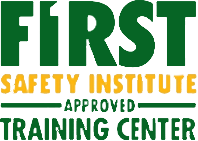Fire Extinguisher

The Fire Extinguisher course is designed to train individuals in the use of portable fire extinguishers in the workplace.
It is designed to help meet Occupational Safety and Health Administration (OSHA) training regulations.
Audience
Individuals requiring training to comply with occupational safety regulations, or anyone desiring training to improve the overall safety of their environment.
Course Format
Instructor-led standardized instructional system with video and skills based demonstration in a classroom environment.
Course Content
- Introduction and Fire Extinguisher Basics
- Fire Extinguisher Use using P.A.S.S technique
- Maintenance and Testing of Fire Extinguishers
Certification
Certificate of successful completion issued by First Safety Institute and valid for up to 12 months, unless otherwise specified by regulation
Features
After completing the course, participants will be able to:
- Compare and Contrast the terms fight or flee
- Understand the need for a proper risk assessment
- State when an evacuation may be necessary
- Identify each element of the Fire Triangle
- Describe the most common classes of fire
- Match the appropriate type of Fire Extinguisher to a specific class of fire
- State the steps in the P.A.S.S Technique
- State the importance of inspections and testing of fire extinguishers
Bloodborne Pathogen
The Bloodborne Pathogen Training Course is a classroom course that teaches employees how to protect themselves and others from being exposed to blood or blood-containing materials.
Usually combined with a First Aid CPR AED training, this course is designed to meet Occupational Safety and Health Administration (OSHA) requirements for bloodborne pathogen training when paired with site-specific instruction.
Audience
This course is designed for anyone with a reasonable chance of coming into contact with bloodborne pathogens such as:
- Correctional Officers
- Childcare workers
- Security guards
- Maintenance workers
- Laboratory Workers
- School personnel
- Hotel housekeepers
- Health and fitness club staff
- Tattoo artists
- Emergency Response Teams
Course Format
Classroom-based (instructor and video, with skills practiced throughout)
Certification
Students receive a Participation Certificate upon course completion.
Course Features
- Classroom based with group interaction and feedback from an instructor
- Designed to meet Occupational Safety and Health Administration (OSHA) requirements for bloodborne pathogens training when paired with site-specific instruction
- Available for first-time or renewal Bloodborne Pathogen training
- During this classroom-based course, an Instructor conducts video-based lessons that reinforce the course content.
- Each student receives their own high quality course materials
Course Content
The Bloodborne Pathogens program covers:
- OSHA Bloodborne Pathogens Standard
- 29 CFR 1910.1030 Specific Bloodborne Pathogens:
- Hepatitis B Virus
- Hepatitis C Virus
- Human Immunodeficiency Virus (HIV)
- Transmitting Bloodborne Pathogens
- Your Employer’s Exposure Control Plan
- Recognizing the Potential for Exposure
- Methods to Control Occupational Risk
- Using Personal Protective Equipment (PPE)
- Hepatitis B Immunization
- When an Exposure Occurs
- Housekeeping
- Communicating a Hazard in the Workplace
Oxygen Administration
Oxygen is a very useful adjunct to first aid care. It is safe and easy to administer as well as improving the patient’s condition and sense of “well being.”
The Oxygen Administration Training Course provides healthcare workers and other professionals with vital information about when to use oxygen, safety precautions, and hands on experience with the various pressure vessels, oxygen adjuncts and equipment.
Course Content
- Benefits and Indications for Emergency Oxygen
- Integrating the Use of Emergency Oxygen
- Emergency Oxygen Delivery Systems
- Oxygen Delivery for Breathing Patient
- Oxygen Delivery for Non-breathing Patient
- Safety Considerations for Emergency Oxygen Use
Class Duration:
1 Hour
Certification
A Course Completion Card will be issued upon completion of the class and is valid for two years.
Business Continuity
Disaster Response and Business Continuity Consulting Services
Disaster Response
An ongoing process to prevent, mitigate, prepare for, respond to, and recover from an incident that threatens life, property, operations or the environment.
Business Continuity
An ongoing process supported by an organization’s management to ensure that the necessary steps are taken to identify the impact of potential losses, maintain viable recovery strategies, recovery plans and continuation of the organization’s services. (NFPA, 1600-2010).
HES Disaster Response and Business Continuity Services include:
Conducting a Gap Analysis
Identifying where there are gaps in the company’s disaster preparedness by interviewing selected employees, as well as evaluating existing documentation.
Areas Covered
- Life Safety procedures for emergencies, including supplies and training
- Crisis Communication procedures and tools
- Mission critical functions and dependencies
- Post Disaster, Damage Assessment and Reporting
- Response Plans for Pandemic Influenza and other illness
Based on the results of the Gap Analysis
Propose the formation of Emergency Response, Business Recovery and Crisis Management Teams that would manage activities and communications before, during and after a disaster.
The Deliverables could include:
- An Emergency Response Team Operations Manual
- A Crisis Communication Plan
- A modified Business Impact Analysis Report
- A Business Recovery Team Operations Manual
- A Crisis Management Team Operations Manual
